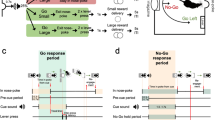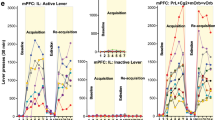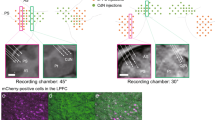Abstract
Goal-directed behavior is believed to involve interactions of prefrontal cortical and limbic inputs in the nucleus accumbens (NAcc), and their modulation by mesolimbic dopamine (DA) seems to be of primary importance in NAcc function. Using in vivo electrophysiological recordings simultaneously with DA system manipulation in rats, we show that tonic and phasic DA release selectively modulates hippocampal and prefrontal cortical inputs through D1 and D2 receptors, respectively. In addition, we also found that D1 activation and D2 inactivation in the NAcc produced behaviorally selective effects (learning versus set shifting of response strategy) that correspond to specific afferents. These results suggest that the dynamics of DA release regulate the balance between limbic and cortical drive through activation and inactivation of DA receptor subtypes in the accumbens, and this regulates goal-directed behavior.
This is a preview of subscription content, access via your institution
Access options
Subscribe to this journal
Receive 12 print issues and online access
$209.00 per year
only $17.42 per issue
Buy this article
- Purchase on Springer Link
- Instant access to full article PDF
Prices may be subject to local taxes which are calculated during checkout







Similar content being viewed by others
References
Mogenson, G.J., Jones, D.L. & Yim, C.Y. From motivation to action: functional interface between the limbic system and the motor system. Prog. Neurobiol. 14, 69–97 (1980).
Groenewegen, H.J., Wright, C.I., Beijer, A.V. & Voorn, P. Convergence and segregation of ventral striatal inputs and outputs. Ann. NY Acad. Sci. 877, 49–63 (1999).
Grace, A.A. Gating of information flow within the limbic system and the pathophysiology of schizophrenia. Brain Res. Brain Res. Rev. 31, 330–341 (2000).
Voorn, P., Jorritsma-Byham, B., Van Dijk, C. & Buijs, R.M. The dopaminergic innervation of the ventral striatum in the rat: a light- and electron-microscopical study with antibodies against dopamine. J. Comp. Neurol. 251, 84–99 (1986).
Berridge, K.C. & Robinson, T.E. What is the role of dopamine in reward: hedonic impact, reward learning, or incentive salience? Brain Res. Brain Res. Rev. 28, 309–369 (1998).
Kelley, A.E. & Berridge, K.C. The neuroscience of natural rewards: relevance to addictive drugs. J. Neurosci. 22, 3306–3311 (2002).
Grace, A.A. Phasic versus tonic dopamine release and the modulation of dopamine system responsivity: a hypothesis for the etiology of schizophrenia. Neuroscience 41, 1–24 (1991).
Floresco, S.B., West, A.R., Ash, B., Moore, H. & Grace, A.A. Afferent modulation of dopamine neuron firing differentially regulates tonic and phasic dopamine transmission. Nat. Neurosci. 6, 968–973 (2003).
Creese, I., Sibley, D.R., Hamblin, M.W. & Leff, S.E. The classification of dopamine receptors: relationship to radioligand binding. Annu. Rev. Neurosci. 6, 43–71 (1983).
Humeau, Y., Popoff, M.R., Kojima, H., Doussau, F. & Poulain, B. Rac GTPase plays an essential role in exocytosis by controlling the fusion competence of release sites. J. Neurosci. 22, 7968–7981 (2002).
Foster, K.A. & Regehr, W.G. Variance-mean analysis in the presence of a rapid antagonist indicates vesicle depletion underlies depression at the climbing fiber synapse. Neuron 43, 119–131 (2004).
Goto, Y. & O'Donnell, P. Timing-dependent limbic-motor synaptic integration in the nucleus accumbens. Proc. Natl Acad. Sci. USA 99, 13189–13193 (2002).
Albertin, S.V., Mulder, A.B., Tabuchi, E., Zugaro, M.B. & Wiener, S.I. Lesions of the medial shell of the nucleus accumbens impair rats in finding larger rewards, but spare reward-seeking behavior. Behav. Brain Res. 117, 173–183 (2000).
Di Chiara, G. Nucleus accumbens shell and core dopamine: differential role in behavior and addiction. Behav. Brain Res. 137, 75–114 (2002).
Charara, A. & Grace, A.A. Dopamine receptor subtypes selectively modulate excitatory afferents from the hippocampus and amygdala to rat nucleus accumbens neurons. Neuropsychopharmacology 28, 1412–1421 (2003).
Greengard, P., Allen, P.B. & Nairn, A.C. Beyond the dopamine receptor: the dopamineRPP-32/protein phosphatase-1 cascade. Neuron 23, 435–447 (1999).
Phillips, P.E. & Wightman, R.M. Extrasynaptic dopamine and phasic neuronal activity. Nat. Neurosci. 7, 199 (2004).
Hall, H., Kohler, C. & Gawell, L. Some in vitro receptor binding properties of [3H]eticlopride, a novel substituted benzamide, selective for dopamine-D2 receptors in the rat brain. Eur. J. Pharmacol. 111, 191–199 (1985).
West, A.R. & Grace, A.A. Opposite influences of endogenous dopamine D1 and D2 receptor activation on activity states and electrophysiological properties of striatal neurons: studies combining in vivo intracellular recordings and reverse microdialysis. J. Neurosci. 22, 294–304 (2002).
Kesner, R.P. & Rogers, J. An analysis of independence and interactions of brain substrates that subserve multiple attributes, memory systems, and underlying processes. Neurobiol. Learn. Mem. 82, 199–215 (2004).
Meck, W.H. & Benson, A.M. Dissecting the brain's internal clock: how frontal-striatal circuitry keeps time and shifts attention. Brain Cogn. 48, 195–211 (2002).
Roberts, A.C. et al. 6-Hydroxydopamine lesions of the prefrontal cortex in monkeys enhance performance on an analog of the Wisconsin Card Sort Test: possible interactions with subcortical dopamine. J. Neurosci. 14, 2531–2544 (1994).
Monchi, O., Petrides, M., Petre, V., Worsley, K. & Dagher, A. Wisconsin card sorting revisited: distinct neural circuits participating in different stages of the task identified by event- related functional magnetic resonance imaging. J. Neurosci. 21, 7733–7741 (2001).
Ragozzino, M.E., Ragozzino, K.E., Mizumori, S.J. & Kesner, R.P. Role of the dorsomedial striatum in behavioral flexibility for response and visual cue discrimination learning. Behav. Neurosci. 116, 105–115 (2002).
Floresco, S.B., Seamans, J.K. & Phillips, A.G. Selective roles for hippocampal, prefrontal cortical, and ventral striatal circuits in radial-arm maze tasks with or without a delay. J. Neurosci. 17, 1880–1890 (1997).
Floresco, S.B. & Phillips, A.G. Dopamine and hippocampal input to the nucleus accumbens play an essential role in the search for food in an upredictable environment. Psychobiol 27, 277–286 (1999).
Christakou, A., Robbins, T.W. & Everitt, B.J. Prefrontal cortical-ventral striatal interactions involved in affective modulation of attentional performance: implications for corticostriatal circuit function. J. Neurosci. 24, 773–780 (2004).
Meyer-Lindenberg, A. et al. Reduced prefrontal activity predicts exaggerated striatal dopaminergic function in schizophrenia. Nat. Neurosci. 5, 267–271 (2002).
Csernansky, J.G. & Bardgett, M.E. Limbic-cortical neuronal damage and the pathophysiology of schizophrenia. Schizophr. Bull. 24, 231–248 (1998).
Grunder, G., Carlsson, A. & Wong, D.F. Mechanism of new antipsychotic medications: occupancy is not just antagonism. Arch. Gen. Psychiatry 60, 974–977 (2003).
Creese, I., Burt, D.R. & Snyder, S.H. Dopamine receptor binding predicts clinical and pharmacological potencies of antischizophrenic drugs. Science 192, 481–483 (1976).
Seeman, P. Dopamine receptors and the dopamine hypothesis of schizophrenia. Synapse 1, 133–152 (1987).
Wong, D.F. et al. Positron emission tomography reveals elevated D2 dopamine receptors in drug-naive schizophrenics. Science 234, 1558–1563 (1986).
Swanson, C.J., Heath, S., Stratford, T.R. & Kelley, A.E. Differential behavioral responses to dopaminergic stimulation of nucleus accumbens subregions in the rat. Pharmacol. Biochem. Behav. 58, 933–945 (1997).
Acknowledgements
We thank N. Macmurdo and C. Smolak for technical assistance, B. Lowry for data acquisition software and A. West and M. Takita for suggestions on reverse microdialysis technique. This work was supported by US National Institute of Mental Health MH57440 (A.A.G.) and a National Alliance for Research on Schizophrenia and Depression (NARSAD) Young Investigator Award (Y.G.). Y.G. is a NARSAD Essel Investigator.
Author information
Authors and Affiliations
Corresponding author
Ethics declarations
Competing interests
The authors declare no competing financial interests.
Supplementary information
Supplementary Fig. 1
Schematic diagrams illustrating how PFC and HPC information processing in the NAcc is modulated by tonic and phasic DA release. (PDF 287 kb)
Rights and permissions
About this article
Cite this article
Goto, Y., Grace, A. Dopaminergic modulation of limbic and cortical drive of nucleus accumbens in goal-directed behavior. Nat Neurosci 8, 805–812 (2005). https://doi.org/10.1038/nn1471
Received:
Accepted:
Published:
Issue Date:
DOI: https://doi.org/10.1038/nn1471
This article is cited by
-
Nucleus accumbens core dopamine D2 receptors are required for performance of the odor span task in male rats
Psychopharmacology (2024)
-
Sex differences in mouse infralimbic cortex projections to the nucleus accumbens shell
Biology of Sex Differences (2023)
-
Entering into a self-regulated learning mode prevents detrimental effects of feedback removal on memory
npj Science of Learning (2023)
-
Aberrations in temporal dynamics of cognitive processing induced by Parkinson’s disease and Levodopa
Scientific Reports (2023)
-
Probing the antidepressant potential of psilocybin: integrating insight from human research and animal models towards an understanding of neural circuit mechanisms
Psychopharmacology (2023)



